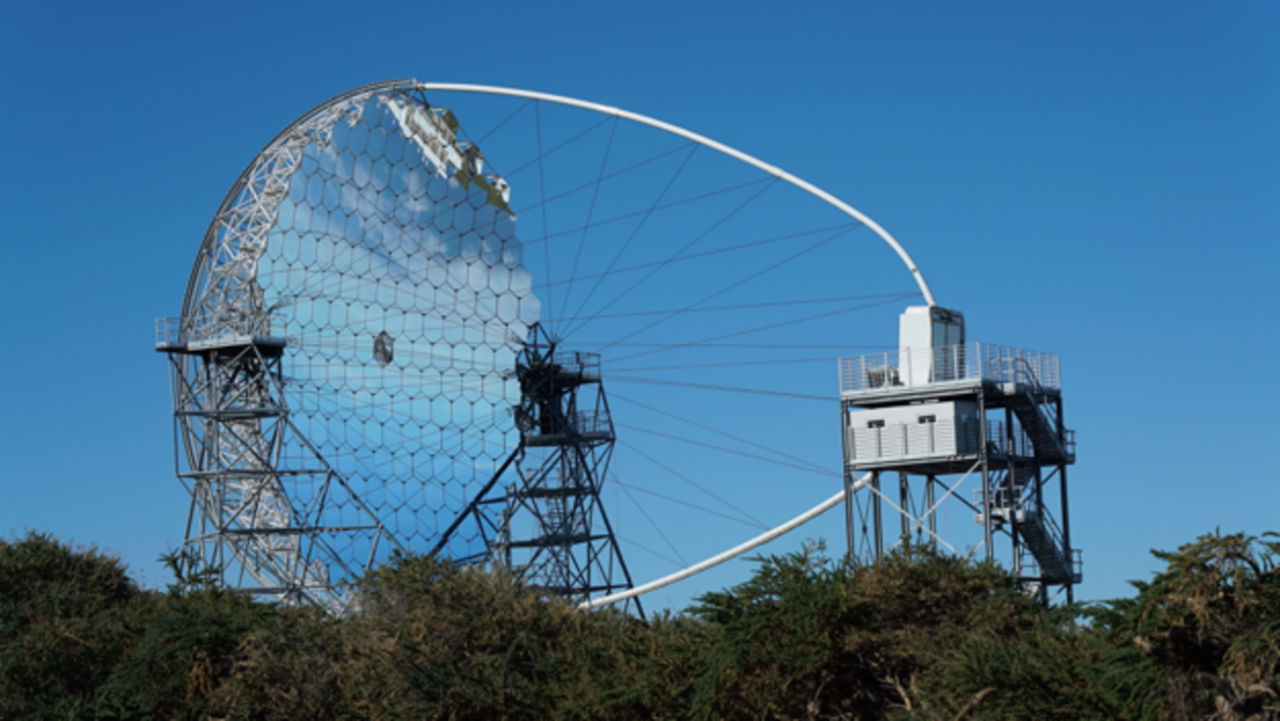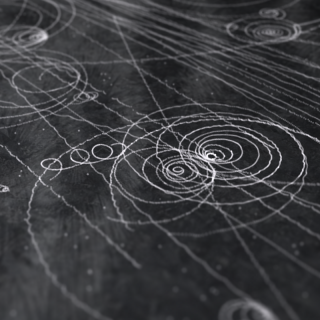Grants related:
General
The MAGIC Collaboration is integrated by 20 research institutes and university departments from Armenia, Bulgaria, Finland, Germany, Italy, Poland, Spain, Switzerland and USA. The collaboration comprises two 17m diameter telescopes, located at the Roque de los Muchachos Observatory, designed to measure the Cherenkov radiation associated with atmospheric showers from very high-energy gamma rays.
CTA is a major international collaboration for building two large Cherenkov observatories at North and South Hemispheres. Roque de los Muchachos Observatory in La Palma has been selected to host the Northern observatory. The first large size telescope was inaugurated in October 2018, and we are presently building the other three.
Members
Results
- Inauguration of the first large-size telescope of CTA (LST-1) at the Observatorio del Roque de Los Muchachos
- Detection of a neutrino generated in a blazar with MAGIC, IcCube and Fermi-LAT
- Discovery of the binary systemPSR J2032+4127/MT91 213 emitting in VHE gamma rays.
Scientific activity
Related publications
-
Improving the performance of the single-dish Cherenkov telescope MAGIC through the use of signal timing
The Cherenkov light flashes produced by extensive air showers are very short in time. A high bandwidth and fast digitizing readout, therefore, can minimize the influence of the background from the light of the night sky, and improve the performance in Cherenkov telescopes. The time structure of the Cherenkov image can further be used in single-dish
Aliu, E. et al.Advertised on:
12009 -
Implementation of the Random Forest method for the Imaging Atmospheric Cherenkov Telescope MAGIC
The paper describes an application of the tree classification method Random Forest (RF), as used in the analysis of data from the ground-based gamma telescope MAGIC. In such telescopes, cosmic gamma-rays are observed and have to be discriminated against a dominating background of hadronic cosmic-ray particles. We describe the application of RF for
Albert, J. et al.Advertised on:
42008 -
First Bounds on the High-Energy Emission from Isolated Wolf-Rayet Binary Systems
High-energy gamma-ray emission is theoretically expected to arise in tight binary star systems (with high mass loss and high-velocity winds), although the evidence of this relationship has proven to be elusive so far. Here we present the first bounds on this putative emission from isolated Wolf-Rayet (WR) star binaries, WR 147 and WR 146, obtained
Aliu, E. et al.Advertised on:
92008 -
FADC signal reconstruction for the MAGIC telescope
Until April 2007 the Major Atmospheric Gamma ray Imaging Cherenkov (MAGIC) telescope used a 300 MSamples/s flash analog-to-digital converter (FADC) system to sample the shaped photomultiplier tube (PMT) signals produced by the captured Cherenkov photons of air showers. Different algorithms to reconstruct the signal from the read-out samples
Albert, J. et al.Advertised on:
92008 -
Upper Limits on the VHE Gamma-Ray Emission from the Willman 1 Satellite Galaxy with the Magic Telescope
We present the result of the observation of the ultrafaint dwarf galaxy Willman 1 performed with the 17 m MAGIC telescope during 15.5 hr between March and May 2008. No significant γ-ray emission was found. We derived upper limits of the order of 10-12 ph cm-2 s-1 on the integral flux above 100 GeV, which we compare with predictions from several of
Aliu, E. et al.Advertised on:
62009 -
Suzaku and Multi-Wavelength Observations of OJ 287 during the Periodic Optical Outburst in 2007
Suzaku observations of the blazar OJ 287 were performed in 2007 April 10-13 and November 7-9. They correspond to a quiescent and a flaring state, respectively. The X-ray spectra of the source can be well-described with single power-law models in both exposures. The derived X-ray photon index and the flux density at 1 keV were found to be Γ = 1.65±0
Seta, Hiromi et al.Advertised on:
102009 -
Simultaneous Multiwavelength Observations of Markarian 421 During Outburst
We report on the results of two coordinated multiwavelength campaigns that focused on the blazar Markarian 421 during its 2006 and 2008 outbursts. These campaigns obtained UV and X-ray data using the XMM-Newton satellite, while the gamma-ray data were obtained utilizing three imaging atmospheric Cerenkov telescopes, the Whipple 10 m telescope and
Acciari, V. A. et al.Advertised on:
92009 -
Simultaneous Multiwavelength Observation of Mkn 501 in a Low State in 2006
We present results of the multiwavelength campaign on the TeV blazar Mkn 501 performed in 2006 July, including MAGIC for the very-high-energy (VHE) γ-ray band and Suzaku for the X-ray band. A VHE γ-ray signal was clearly detected with an average flux above 200 GeV of ~20% of the Crab Nebula flux, which indicates a low state of source activity in
Anderhub, H. et al.Advertised on:
112009 -
Simultaneous multi-frequency observation of the unknown redshift blazar PG 1553+113 in March-April 2008
The blazar PG 1553+113 is a well known TeV γ-ray emitter. In this paper we determine its spectral energy distribution through simultaneous multi-frequency data to study its emission processes. An extensive campaign was carried out between March and April 2008, where optical, X-ray, high-energy (HE) γ-ray, and very-high-energy (VHE) γ-ray data were
Aleksić, J. et al.Advertised on:
62010 -
Search for VHE γ-ray Emission from the Globular Cluster M13 with the Magic Telescope
Based on MAGIC observations from 2007 June to July, we have obtained an integral upper limit to the VHE energy emission of the globular cluster M13 of F(E>200 GeV) < 5.1 × 10-12 cm-2 s-1, and differential upper limits for E > 140 GeV. Those limits allow us to constrain the population of millisecond pulsars within M13 and to test models for
Anderhub, H. et al.Advertised on:
92009 -
Search for an extended VHE γ-ray emission from Mrk 421 and Mrk 501 with the MAGIC Telescope
Context. Part of the very high energy γ-ray radiation coming from extragalactic sources is absorbed through the pair production process on the extragalactic background light photons. Extragalactic magnetic fields alter the trajectories of these cascade pairs and, in turn, convert cosmic background photons to γ-ray energies by inverse Compton
Aleksić, J. et al.Advertised on:
122010 -
Radio Imaging of the Very-High-Energy γ-Ray Emission Region in the Central Engine of a Radio Galaxy
The accretion of matter onto a massive black hole is believed to feed the relativistic plasma jets found in many active galactic nuclei (AGN). Although some AGN accelerate particles to energies exceeding 1012 electron volts and are bright sources of very-high-energy (VHE) γ-ray emission, it is not yet known where the VHE emission originates. Here
Acciari, V. A. et al.Advertised on:
72009 -
Periodic Very High Energy γ-Ray Emission from LS I +61°303 Observed with the MAGIC Telescope
The MAGIC collaboration has recently reported the discovery of γ-ray emission from the binary system LS I +61°303 in the TeV energy region. Here we present new observational results on this source in the energy range between 300 GeV and 3 TeV. In total, 112 hr of data were taken between 2006 September and December covering four orbital cycles of
Albert, J. et al.Advertised on:
32009 -
MAGIC upper limits to the VHE gamma-ray flux of 3C 454.3 in high emission state
Aims: We report upper limits to the very high energy flux (E>100 GeV) of the flat spectrum radio quasar 3C 454.3 (z=0.859) derived by the Cherenkov telescope MAGIC during the high states of July/August and November/December 2007. We compare the upper limits derived in both time slots with the available quasi-simultaneous MeV-GeV data from the AGILE
Anderhub, H. et al.Advertised on:
42009 -
MAGIC Upper Limits for Two Milagro-detected Bright Fermi Sources in the Region of SNR G65.1+0.6
We report on the observation of the region around supernova remnant G65.1+0.6 with the stand-alone MAGIC-I telescope. This region hosts the two bright GeV gamma-ray sources 1FGL J1954.3+2836 and 1FGL J1958.6+2845. They are identified as GeV pulsars and both have a possible counterpart detected at about 35 TeV by the Milagro observatory. MAGIC
Aleksić, J. et al.Advertised on:
122010 -
MAGIC TeV gamma-ray observations of Markarian 421 during multiwavelength campaigns in 2006
Context. Wide-range spectral coverage of blazar-type active galactic nuclei is of paramount importance for understanding the particle acceleration mechanisms assumed to take place in their jets. The Major Atmospheric Gamma Imaging Cerenkov (MAGIC) telescope participated in three multiwavelength (MWL) campaigns, observing the blazar Markarian (Mkn)
Aleksić, J. et al.Advertised on:
92010 -
MAGIC observation of the GRB 080430 afterglow
Context. Gamma-ray bursts are cosmological sources emitting radiation from the gamma-rays to the radio band. Substantial observational efforts have been devoted to the study of gamma-ray bursts during the prompt phase, i.e. the initial burst of high-energy radiation, and during the long-lasting afterglows. In spite of many successes in interpreting
Aleksić, J. et al.Advertised on:
72010 -
MAGIC Gamma-ray Telescope Observation of the Perseus Cluster of Galaxies: Implications for Cosmic Rays, Dark Matter, and NGC 1275
The Perseus galaxy cluster was observed by the MAGIC Cherenkov telescope for a total effective time of 24.4 hr during 2008 November and December. The resulting upper limits on the γ-ray emission above 100 GeV are in the range of 4.6-7.5 × 10-12 cm-2 s-1 for spectral indices from -1.5 to -2.5, thereby constraining the emission produced by cosmic
Aleksić, J. et al.Advertised on:
22010 -
Magic Constraints on γ-ray Emission from Cygnus X-3
Cygnus X-3 is a microquasar consisting of an accreting compact object orbiting around a Wolf-Rayet star. It has been detected at radio frequencies and up to high-energy γ rays (above 100 MeV). However, many models also predict a very high energy (VHE) emission (above hundreds of GeV) when the source displays relativistic persistent jets or
Aleksić, J. et al.Advertised on:
92010 -
Discovery of very High Energy γ-Rays from the Blazar S5 0716+714
The MAGIC Collaboration reports the detection of the blazar S5 0716+714 (z = 0.31 ± 0.08) in very high energy gamma rays. The observations were performed in 2007 November and in 2008 April, and were triggered by the Kungliga Vetenskapliga Akademi telescope due to the high optical state of the object. An overall significance of the signal accounts
Anderhub, H. et al.Advertised on:
102009



